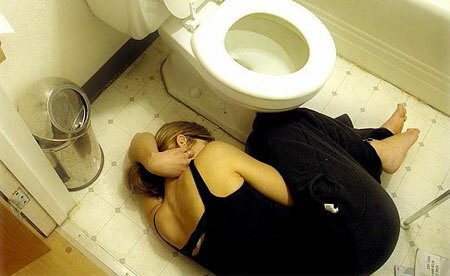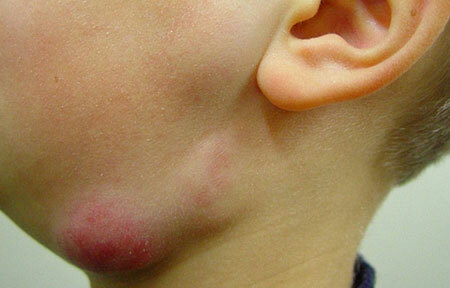The most important part of the musculoskeletal system - the heel - can withstand the weight of the whole body and performs a cushioning function in combination with other bones of the foot.
Any damage to this area makes it difficult for a person to move, and sometimes they are not allowed to get out of bed. Patients of different ages go to the doctor with complaints of pain in the heel.
What is it can be and how to treat? It all depends on the reasons, but not so few.
Content
- 1 reasons for heel pain
- 1.1 diseases causing heel pain
- 1.2 physical injury
- 1.3 non-pathological causes
- 2 Diagnosing heel pain
- 3 Treatment of heel pain
- 3.1 Prevention
- 3.2 Conclusion
reasons for heel pain
In clinical practice, such a large number of diseases that provoke the same symptom and have a different etiology are rare enough.
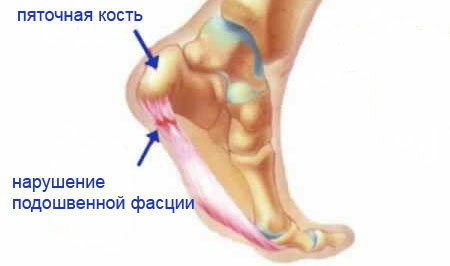
Causes of heel pain - plantar fasciitis
For example, cough develops as a result of pulmonary disorders, and diarrhea is caused by a violation of the intestinal microflora or functions of the digestive organs. With such ailments everything is clear, and the treatment is known in advance.
However, severe pain in the heel when attack occurs for various reasons, the classification of which physicians represent in the following form:
- Diseases( systemic and local).
- Physical Injuries.
- Non-pathological causes.
Diseases that cause pain in the heel
First of all, doctors focus on local diseases that develop due to various factors:
- Plantar fasciitis ( inflammation of the connective tissue).Another such disorder is called a "calcaneal spur".The result is a bony growth that causes pain in the heel when walking.
- Achillodynia ( inflammation of the Achilles tendon).Usually is a consequence of an injury.
- Bursitis ( inflammation of the joint bag).The accumulated exudate in the joint provokes additional complications.
- Haglund-Schintz disease .Necrosis of tissues due to increased mechanical action.
- Disease of the North .Unpleasant sensations arise from a prolonged load( running).Often diagnosed in children during the active growth of the skeleton.
- Neuralgic Diseases .Nerve compression in the area of the heel leads to burning pain.
- Congenital pathology of the .This includes flat feet, and the curvature of the axis of the feet.
- Osteomyelitis .The heel bone is deformed and atrophied( the disease can be generalized).
Systemic diseases that affect the body as a whole, are reflected on the heel. And if it is not so difficult to cope with local disorders, general pathologies require complex treatment.
- Rheumatoid arthritis .Degenerative changes affect the ankle joint.
- Tumor .A good or malignant neoplasm changes the normal structure of the tissues. In addition, cancer metastases from other organs( lungs, liver, etc.) are able to reach heels.
- Tuberculosis of bones. Usually accompanied by necrosis of bone tissue.
- Gout. A metabolic disorder leads to the deposition of salts both throughout the body and in the foot area.
- Infectious diseases .Untimely or substandard treatment favors the spread of pathogenic bacteria throughout the body.
- Bechterew's disease. The ossification of the vertebral joints disrupts the normal distribution of the load, which results in pain in the heels.
- Diabetes mellitus often provokes very painful cracks on the heels.
Physical injuries
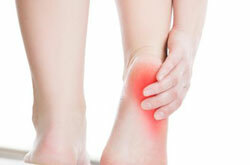 In the sports world, you can not do without injuries. However, ordinary people risk stretching or breaking the tendon in the heel, which causes severe pain.
In the sports world, you can not do without injuries. However, ordinary people risk stretching or breaking the tendon in the heel, which causes severe pain.
Often faced with this untrained runners who have decided to boast of speed and maneuverability or children. In addition, each person can easily stumble when walking and turn the foot - the stretching will be almost always.
Often, bruises also occur. For example, when jumping from a high altitude or impact. In this case, pain in the heel is localized from the inside or outside, i.e.in the place of damage.
And although in this case it usually bothers only 2-3 days, sometimes the situation is complicated by a crack in the bone or even a fracture. And it really will be a problem for the next couple of months: no stress on the damaged leg, the recumbent mode, the movement on crutches.
Non-pathological causes of
But not only diseases and injuries provoke pain in the heel. The musculoskeletal system can simply get tired of too much human activity. The causes of this kind are not classified as pathological, therefore they are placed in a separate category:
- Overexertion of foot tissues. As a rule, appears because of uncomfortable shoes.
- No rest. If you walk or stand on your feet all day, this will necessarily affect your heels.
- Weight gain. Especially dangerous with severe obesity. The footsteps will take some time to strengthen the bone.
If there are pains in the heel in the morning or after rest, then they are treated as a residual phenomenon after the loads. Suffer this disorder people who are constantly on their feet( for example, postmen, sellers, security guards, etc.).
Often, even sleep does not eliminate discomfort. With this development of events, doctors recommend to think about changing the type of activity.
Diagnosis of heel pain
Which doctor should I consult if I have pain in the heel?- First of all, to the traumatologist.
The doctor will examine the foot and ask the patient about previous events. Do not keep silent about bruises, podtytyvani legs or profession, because these reasons to eliminate the simplest.
Much more dangerous are considered various diseases, for the diagnosis of which it is required to conduct a whole complex of measures:
- X-ray study. Visually demonstrates the structure of tissues. Assign in the first place.
- Ultrasound, MRI and CT.It is required to refine the results of X-rays and if there is a suspicion of cancer.
- Biopsy. Analyze changes in the structure of bone tissue( for example, in tuberculosis).
- Conductivity study of neurons. It is required to exclude a neuralgic disorder.
- Blood test. Determine the concentration of sugar and uric acid, the presence of oncomarkers and prostaglandins.
- Bacteriological analysis. Investigate the composition of the synovial fluid for the presence of bacteria.
Treat heel pain only after examination. To someone it will seem too voluminous, but the error in this case can cost if not spent time, then deterioration in health.
Treatment of heel pain

The most common cause of pain in the heel is the "spur".This disease is treated with non-steroidal anti-inflammatory drugs( NSAIDs), among which Diclofenac and Finalgel are considered effective.
But doctors use medicines based on their own experience and clinical picture of the disease, so do not consider these drugs as panacea.
In the absence of shifts in the positive direction, additional measures are prescribed:
- drug blockade of the joint;
- electrophoresis;
- UHF;
- compresses either on the heel or on the entire foot( Novokain, Dimexid);
- special gymnastics and massage.
By the way, similar agents are shown in both fasciitis, bursitis, and achillodynia. However, if the cause of pain in the heel when walking after sleep is not a spur or similar inflammation, then the course of treatment will be different. Everything depends on the primary disease.
For example, diabetes requires normalization of pancreatic function, infectious diseases - elimination of pathogenic microorganisms, neuralgic - restoration of conduction of neurons.
If the medications failed to get rid of severe pain in the heel and the situation is aggravated, then they resort to surgical intervention.
Of course, it is carried out very rarely, but with the rupture of tendons - is inevitable. Even the plantar spur is sometimes excised, and in the case of a good or malignant tumor, surgery can be the only treatment option.
Prevention of
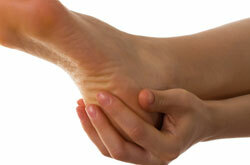 It is not always possible to prevent such an unpleasant symptom. In the presence of a generalized disease without comprehensive treatment can not do. However, pain in the heel often occurs for other reasons. How to prevent a turn of events for the worse?
It is not always possible to prevent such an unpleasant symptom. In the presence of a generalized disease without comprehensive treatment can not do. However, pain in the heel often occurs for other reasons. How to prevent a turn of events for the worse?
- Reduce the number of hours spent on your feet.
- Regularly perform gymnastics for feet.
- Get rid of excess weight.
- Wear only comfortable shoes.
- Strengthen immunity.
- Do not delay the treatment of diseases.
- Protect your feet from injury.
Conclusion
Heel pain is usually the result of increased stress on the legs. You can not exclude options for the development of local or systemic diseases, coping with which is very difficult.
In any case, when this symptom occurs, you should consult a doctor for diagnosis.

